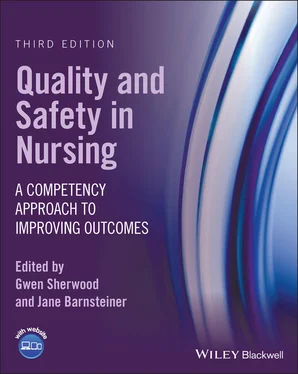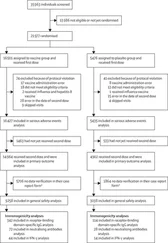Quality and Safety in Nursing
Здесь есть возможность читать онлайн «Quality and Safety in Nursing» — ознакомительный отрывок электронной книги совершенно бесплатно, а после прочтения отрывка купить полную версию. В некоторых случаях можно слушать аудио, скачать через торрент в формате fb2 и присутствует краткое содержание. Жанр: unrecognised, на английском языке. Описание произведения, (предисловие) а так же отзывы посетителей доступны на портале библиотеки ЛибКат.
- Название:Quality and Safety in Nursing
- Автор:
- Жанр:
- Год:неизвестен
- ISBN:нет данных
- Рейтинг книги:5 / 5. Голосов: 1
-
Избранное:Добавить в избранное
- Отзывы:
-
Ваша оценка:
- 100
- 1
- 2
- 3
- 4
- 5
Quality and Safety in Nursing: краткое содержание, описание и аннотация
Предлагаем к чтению аннотацию, описание, краткое содержание или предисловие (зависит от того, что написал сам автор книги «Quality and Safety in Nursing»). Если вы не нашли необходимую информацию о книге — напишите в комментариях, мы постараемся отыскать её.
Quality and Safety in Nursing
Future of Nursing
Quality and Safety in Nursing, Third Edition
Quality and Safety in Nursing — читать онлайн ознакомительный отрывок
Ниже представлен текст книги, разбитый по страницам. Система сохранения места последней прочитанной страницы, позволяет с удобством читать онлайн бесплатно книгу «Quality and Safety in Nursing», без необходимости каждый раз заново искать на чём Вы остановились. Поставьте закладку, и сможете в любой момент перейти на страницу, на которой закончили чтение.
Интервал:
Закладка:
Library of Congress Cataloging‐in‐Publication Data
Names: Sherwood, Gwen, editor. | Barnsteiner, Jane Herman, editor.
Title: Quality and safety in nursing : a competency approach to improving outcomes / edited by Gwen Sherwood, Jane Barnsteiner.
Description: Third edition. | Hoboken, New Jersey : Wiley‐Blackwell, [2022]
Identifiers: LCCN 2021035012 (print) | LCCN 2021035013 (ebook) | ISBN 9781119684237 (paperback) | ISBN 9781119684244 (adobe pdf) | ISBN 9781119684459 (epub)
Subjects: MESH: Nursing Care–standards | Education, Nursing–standards | Quality Improvement | Safety Management | Treatment Outcome | United States
Classification: LCC RT41 (print) | LCC RT41 (ebook) | NLM WY 100 AA1 | DDC 610.73–dc23
LC record available at https://lccn.loc.gov/2021035012LC ebook record available at https://lccn.loc.gov/2021035013
Cover Design: Wiley
Cover Image: © Ralf Hiemisch/Getty Images
We dedicate this work
To faculty, students, and clinicians locally and globally who are successfully implementing the work of QSEN. On a daily basis your work demonstrates the commitment that the highest‐quality, safest care can only be achieved when all clinicians are delivering person‐ and family‐centered care as members of an interprofessional team , emphasizing application of evidence‐based practice, safety, quality improvement , and informatics .
To everyone who honored the commitment to provide exceptional patient and family services during the ongoing global pandemic. You have willingly cared for all in spite of the risks to your own safety and well‐being, and that of your families. We all thank you for continual just‐in‐time learning, innovations, and compassion in the face of trying circumstances.
To educators whose commitment never wavered in the global pandemic. You immediately revamped nursing education to ensure continuity in preparing the next generations of nurses through your bold creativity, resourcefulness, and dedication to purpose.
Contributors
Editors
Gwen Sherwood, PhD, RN, FAAN, ANEFProfessor Emeritus School of Nursing University of North Carolina at Chapel Hill Chapel Hill, NC, USA
Jane Barnsteiner, PhD, RN, FAANProfessor Emerita School of Nursing University of Pennsylvania Philadelphia, PA, USA Editor, Translational Research and QI, American Journal of Nursing Contributors
Jennifer T. Alderman, PhD, MSN, RN, CNL, CNE, CHSEAssociate Professor School of Nursing University of North Carolina at Chapel Hill Chapel Hill, NC, USA
Gail Armstrong, PhD, DNP, ACNS‐BC, CNEProfessor, Assistant Dean DNP Program Oregon Health & Science University Portland, OR, USA
Elizabeth Cerbie Brown, MSN, RNGalen University Indianapolis, IN, USA
Thomas R. Clancy, MBA, PhD, RN, FAANProfessor ad Honorem University of Minnesota School of Nursing Minneapolis, MN, USA
Linda R. Cronenwett, PhD, RN, FAANDean Emeritus and Professor Emeritus UNC‐Chapel Hill School of Nursing Chapel Hill, NC, USA
Lisa Day, PhD, RN, CNE, ANEF, FAANProfessor University of New Mexico College of Nursing Albuquerque, NM, USA
Joanne Disch, PhD, RN, FAANProfessor ad Honorem University of Minnesota School of Nursing Minneapolis, MN, USA
Mary A. Dolansky, PhD, RN, FAANSarah C. Hirsh Professor Director, QSEN Institute Senior Faculty Scholar, VA Quality Scholars Program Frances Payne Bolton School of Nursing Case Western Reserve University Cleveland, OH, USA
Carol F. Durham, EdD, RN, ANEF, FSSH, FAANProfessor Director, QSEN Regional Center UNC‐Chapel Hill School of Nursing Chapel Hill, NC, USA
Margo A. Halm, PhD, RN, NEA‐BCAssociate Chief Nurse Executive, Nursing Research & Evidence‐Based Practice VA Portland Health Care System Portland, OR, USA
Pamela M. Ironside, PhD, RN, FAAN, ANEFProfessor Emerita Prairie du Sac, WI, USA
Jean Johnson, PhD, RN, FAANEmerita Dean and Professor George Washington University School of Nursing Washington, DC, USA
Joan Kavanagh, PhD, RN, NEA‐BCAssociate Chief Nursing Officer Education and Professional Development Cleveland Clinic Health System Cleveland, OH, USA
Ellen Luebbers, MDVA Quality Scholars Fellow Louis Stokes Cleveland VA Medical Center Case Western Reserve University School of Medicine Cleveland, OH, USA
Shirley M. Moore, PhD, RN, FAANProfessor Emerita Frances Payne Bolton School of Nursing Case Western Reserve University Cleveland, OH, USA
Bethany Robertson, DNP, CNM, FNAPAssociate Professor, Clinical Emory University Nell Hodgson Woodruff School of Nursing Atlanta, GA, USA
Mary Jean Schumann, DNP, MBA, RN, CPNP‐PC, FAANAssociate Professor of Nursing George Washington University School of Nursing Washington, DC, USA
Mamta K. Singh, MD, MSAssociate Professor of Medicine Case Western Reserve University School of Medicine Louis Stokes Cleveland Veterans Affairs Medical Center Cleveland, OH, USA
Nancy Spector, PhD, RN, FAANDirector of Regulatory Innovations National Council of State Boards of Nursing Chicago, IL, USA
Mary Fran Tracy, PhD, RN, APRN, CNS, FCNS, FAANAssociate Professor University of Minnesota School of Nursing University of Minnesota Medical Center Minneapolis, MN, USA
Judith J. Warren, PhD, RN, BC, FAAN, FACMIConsultant, Warren Associates, LLC Plattsmouth, NE, USA
Amy Hagedorn Wonder, PhD, RNAssistant Professor Indiana University School of Nursing Bloomington, IN, USA Meg Zomorodi, PhD, RN, FAAN, ANEF Assistant Provost and Director Office of Interprofessional Education and Practice Professor UNC‐Chapel Hill School of Nursing Chapel Hill, NC, USA
Foreword
Twenty years ago, the groundbreaking report To Err Is Human spotlighted the failure of the US health care system to protect patients from preventable harm. The report called for sweeping recommendations to improve patient safety and quality, including viewing medical errors as systemic problems, rather than individual mistakes. Nurse leaders responded to the urgent call to improve patient safety, and in 2005, the Robert Wood Johnson Foundation’s Quality and Safety Education in Nursing (QSEN) program was born. QSEN sought to intentionally integrate specific quality and safety concepts into nursing and other health profession curricula to prepare new nurses to improve quality and safety where they work. While initially focused on educating faculty to teach students competencies for use in hospital settings, QSEN expanded its focus to educating practicing nurses to use the competencies as the framework for practice, professional development, promotion, and evaluation across all types of care settings.
The award‐winning Quality and Safety Education in Nursing: A Competency Approach to Improving Outcomes was the first nursing textbook dedicated to widely sharing the QSEN competencies in order to improve patient safety and quality. As the third edition goes to press, health care leaders once again are grappling with irrefutable evidence of the shortcomings and systemic failures of the US health care system. The COVID‐19 pandemic has taken a devastating toll on the front‐line health care workforce and exposed the fractures within the systems that have a responsibility to protect nurses and other health care workers (Ulrich et al ., 2020). Family members were not allowed to visit their loved ones, making it difficult for health care workers to incorporate patient engagement strategies, which have been shown to improve patient safety and quality (Hassmiller and Bilazarian, 2018). The pandemic has also laid bare long‐existing health inequities that have persisted for generations. As of June 2021, more than 600,000 people have died from COVID—a disproportionate number of whom have been people of color (APM Research Lab, 2021). Health care leaders are faced with a choice: to maintain the status quo, or to commit to a more just future.
Читать дальшеИнтервал:
Закладка:
Похожие книги на «Quality and Safety in Nursing»
Представляем Вашему вниманию похожие книги на «Quality and Safety in Nursing» списком для выбора. Мы отобрали схожую по названию и смыслу литературу в надежде предоставить читателям больше вариантов отыскать новые, интересные, ещё непрочитанные произведения.
Обсуждение, отзывы о книге «Quality and Safety in Nursing» и просто собственные мнения читателей. Оставьте ваши комментарии, напишите, что Вы думаете о произведении, его смысле или главных героях. Укажите что конкретно понравилось, а что нет, и почему Вы так считаете.












